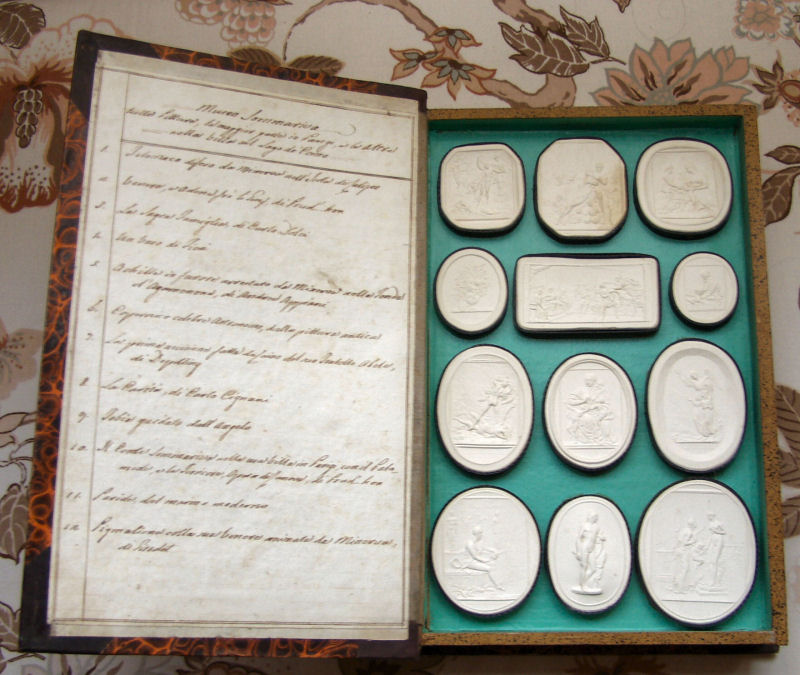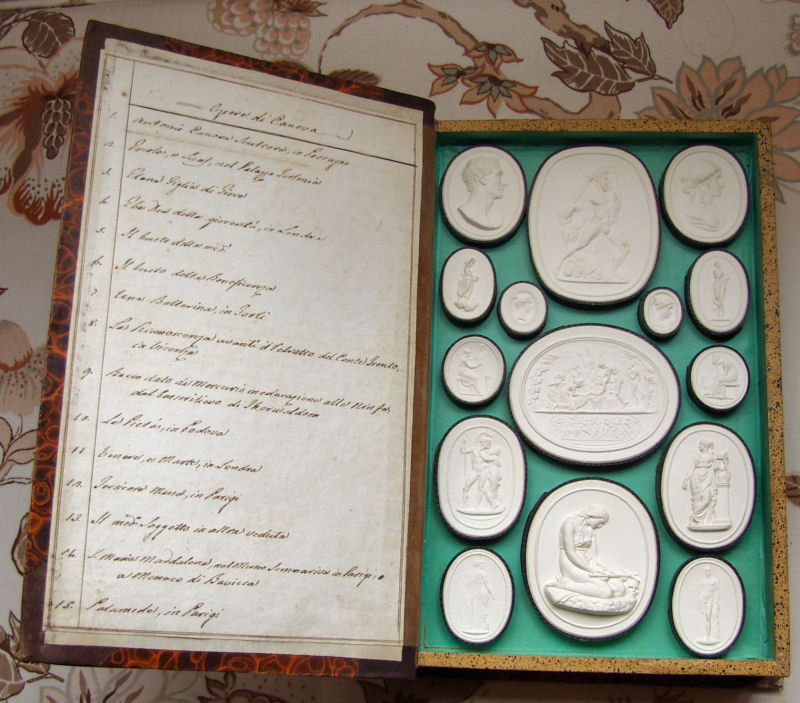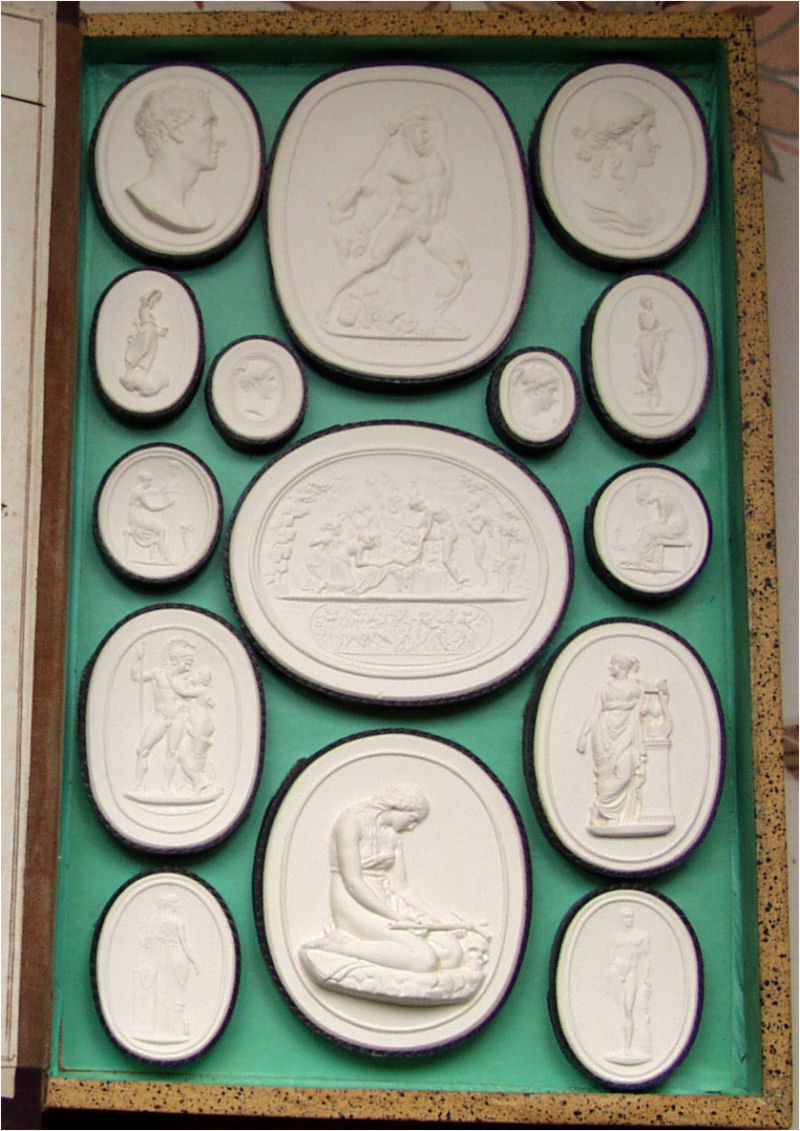| |
Pietro Paoletti (1801-1847)
and his collection of intaglios
Made in Rome by Pietro Paoletti, at his Studio in Piazza di Spagna N.49
The Grand Tour was the traditional trip around Europe, often lasting three to four years, undertaken by the wealthy upper-class English during the 16th and 17th century. Their prime interest was to visit cities that were considered major centres of culture; Paris, Rome, Venice, Florence and Naples were popular destinations.
During the 18th and 19th century, the opportunity to take the "Grand Tour" spread from the aristocracy to the new industrial and professional elites, tourist destinations such as Rome shifted their attention from the privileged class to meeting the travel needs of the monied middle-class, including a healthy souvenir trade.
Souvenir engravings of tourist attractions began to appear everywhere. In addition to albums of engraved views, the Grand Tour offered another very popular type of travel souvenir, the now nearly forgotten cameos. The taste for these engraved antique gems was revived as part of the classical revival and later reproduced as miniature plaster casts. Mounted in faux book bindings, these plaster cameos provided a minutely detailed cabinet of neoclassical knowledge and art. (Princeton University).
Here you see an example of these plaster cast cameos/intaglios; an early 19th century collection of plaster cast impressions by Pietro Paoletti in twelve leather-bound faux volumes, each stamped in gold lettering on the spine Paoletti Impronte, and individually beneath Opere di vari Auttori, Museo Capitolino, Museo di Firenze e Parigi, Museo di Napoli, Villa Albani e Sommariva, Museo Sommariva, Museo Vaticano, Opere di Canova, Opere di Gibson e Opere di Thorwaldsen. Each volume hand inscribed on the interior with details of its contents. This particular set is housed in a purpose made mahogany case with sliding lid.
Description: Presented in leather-bound faux books, each spine marked Paoletti, each containingplaster cameos with a handwritten description of each with provenance when applicable, comprising: Museo Sommariva; Museo di Firenze; Edifici; Monumenti in vari luoghi; Opera di Thorwaldsen [2]; Uomini Illustri [2]; Museo Capitolino; Museo di Napoli; Opera di Canova; Museo Vaticano.
Notes: Making casts from engraved gems, or cameos, was a common practice from ancient times, and was particularly popular among Roman connoisseurs of the 18th century. When such plaster casts became popular souvenirs for Grand Tour travelers in the early 19th century, several shops opened which specialized in them. These souvenir casts not only represented carved gems, but also contemporary and ancient sculptures and monuments, and were often mounted in faux book bindings, as in the present example. The Scotsmen James and William Tassie were among the most prolific casters, as were Bartolomeo Paoletti (1757-1834) and his son, Pietro (1801-1847). The Paoletti firm advertised themselves in Count Hawks Le Grice's guide Walks though the Studii of the Sculptors at Rome (1841) as follows: Paoletti begs to inform the public that he has arranged a collection of impressions (Impronte in Scajola) of many of the works in sculpture executed by distinguished artists ... Although the Impronte are but miniature copies; yet they exhibit all the fidelity and beauty of the original, and convey to the eye a better idea of sculpted works of art than the most finished engravings. The Paolettis, whose studio was located on the Piazza di Spagna in Rome until 1847, enjoyed a stellar reputation, and counted among their clients Catherine the Great of Russia and Ferdinand III, Grand Duke of Tuscany. The firm continued to do business after the death of Pietro until at least 1865. The present example dates from the lifetime of Bartolomeo, however, as evidenced by the following inscription found in two of the volumes: Si fanno in Roma da Bartolomeo Paoletti, e Pietro figlio, dimoranti di Studio in Piazza di Spagna num° 49. Examples of the Paolettis' casts are conserved in the Victoria & Albert Museum, London, and the Yale Center for British Art, New Haven, Connecticut.
Provenance: Niall Smith Antiques, New York


Count Hawks Le Grice wrote of Paoletti's works in his 'Walks through the Studii of the Sculptors at Rome 1841', "Although the Impronte are but miniature copies, they exhibit all the fidelity and beauty of the originals, and convey to the eye a better idea of sculptured works of art than the most finished engravings. The Studio of Paoletti is in Piazza di Spagna No. 49, where collections in impronte may be had of all the works existing in the different Museums in Europe." |
| |

Opere di vari Auttori (Works by various artists) |
| |
| |

Opere di vari Auttori (Works by various artists) |
| |
| |

Opere di vari Auttori (Works by various artists) |
| |
| |

Opere di vari Auttori (Works by various artists) |
| |
| |

Opere di vari Auttori (Works by various artists) |
| |
| |

Opere di vari Auttori (Works by various artists) |
| |
| |

Opere di vari Auttori (Works by various artists) |
| |
| |

Opere di vari Auttori (Works by various artists) |
| |
| |

Opere di vari Auttori (Works by various artists) |
| |
| |

Opere di vari Auttori (Works by various artists) |
| |
| |

Opere di vari Auttori (Works by various artists) |
| |
| |

Opere di vari Auttori (Works by various artists) |
| |
| |

Museo Capitolini, Roma |
| |
| |

Museo Capitolini, Roma |
| |
| |

Museo Capitolini, Roma |
| |
| |

Museo Capitolini, Roma |
| |
| |

Museo di Firenze |
| |
| |

Museo di Firenze |
| |
| |

Museo di Parigi |
| |
| |

Museo di Parigi |
| |
| |

Museo di Napoli |
| |
| |

Museo di Napoli |
| |
| |

Museo della Villa Albani e Museo Sommariva |
| |
| |

Museo della Villa Albani e Museo Sommariva |
| |
| |

Museo Sommariva |
| |
| |

Museo Sommariva |
| |
| |

Museo Sommariva |
| |
| |

Museo Sommariva |
| |
| |

Museo Vaticano |
| |
| |

Museo Vaticano |
| |
| |

Museo Vaticano |
| |
| |

Museo Vaticano |
| |
| |

Opere di Canova (Works by Antonio Canova) |
| |
| |

Opere di Canova (Works by Antonio Canova) |
| |
| |

Opere di Canova (Works by Antonio Canova) |
| |
| |

Opere di Canova (Works by Antonio Canova) |
| |
| |

Opere di Gibson (Works by John Gibson) |
| |
| |

Opere di Gibson (Works by John Gibson) |
| |
| |

Opere di Gibson (Works by John Gibson) |
| |
| |

Opere di Gibson (Works by John Gibson) |
| |
| |

Opere di Thorwaldsen (Works by Bertel Thorwaldsen) |
| |
| |

Opere di Thorwaldsen (Works by Bertel Thorwaldsen) |
| |
| |

Opere di Thorwaldsen (Works by Bertel Thorwaldsen) |
| |
| |

Opere di Thorwaldsen (Works by Bertel Thorwaldsen) |
| |
| |

Opere di Thorwaldsen (Works by Bertel Thorwaldsen) |
| |
| |

Opere di Thorwaldsen (Works by Bertel Thorwaldsen) |
| |
| |

Opere di Thorwaldsen (Works by Bertel Thorwaldsen) |
| |
| |

Opere di Thorwaldsen (Works by Bertel Thorwaldsen) |
| |
The Princeton University Numismatic Collection
THE FIRESTONE ROMAN COLLECTION, including "Greek imperials" . Over 5,800 coins: 650 of the Roman Republic, mostly silver; over 5,200 of the Roman Empire, mostly silver and bronze, to Anastasius (ca.35 BCE-491 CE). Contents of the Firestone Princeton collection from the Republic through Commodus (ca.2,000 coins) have been published by B. Levy and P.C.V. Bastien, Roman Coins in the Princeton University Library I (Wetteren, 1985). There are notable holdings in the coinage of Roman Corinth, the 1976 gift of Prof. and Mrs. T. Leslie Shear, Jr.; about 100 of these are recorded in M.Amandry, Le monnayage des duovirs corinthiens (Paris, 1988).
With the Greek and Roman coins should be mentioned two associated holdings:
(1) The foundation piece of Princeton's collection, a group of over 5,000 plaster casts of classical coins, bought by friends and alumni of the institution in 1849, and still in their original wooden trays.
(2) Twelve cased volumes of impronte, i.e. plaster casts of classical (and modern) intaglio gems, made up by the Roman firm of Paoletti, active in the 18th and 19th centuries. |
| |


















































